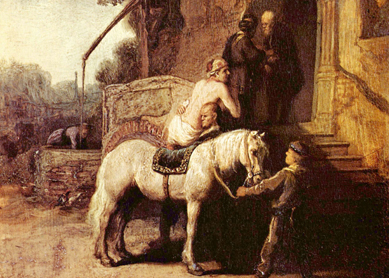When Jesus reached the famous well at Shechem and asked a Samaritan woman for a drink, she replied full of surprise: “Jews do not associate with Samaritans” (
It is difficult to know when the enmity first arose in history—or for that matter, when Jews and Samaritans started seeing themselves (and each other) as separate communities. For at least some Jews during the Second Temple period,
The Samaritans, for their part, did not accept any scriptural texts beyond the Pentateuch. Scholars have known for a long time about an ancient and distinctly Samaritan version of the Pentateuch—which has been an important source for textual criticism of the Bible for centuries. In fact, a major indication for a growing Samaritan self-awareness in antiquity was the insertion of “typically Samaritan” additions into this version of the Pentateuch, such as a Decalogue commandment to build an altar on Mount Gerizim, which Samaritans viewed as the sole “place of blessing” (see also
The aggressive expansion of the Jewish Hasmonean kingdom and the destruction of the sanctuary and the city on Mount Gerizim in 110 B.C.E. further deepened the rift between Samaritans and Jews. Countering the claims of the “Jewish heretics in Jerusalem,” the Samaritans consequently saw and still see themselves as the true Israelites and “keepers of the covenant” (shomronim or shomrim in Hebrew, echoing the Hebrew name for Samaria, Shomron).
Despite all these polemical traditions, however, Samaritans and Jews had much more in common than we might think. Both based their faith on the Pentateuch. Rather than a “split” at one particular moment, the relation between Samaritans and Jews is characterized by a long process of alienation and parallel development between the fourth–third centuries B.C.E. and the fourth century C.E. Because the Samaritans only accepted the Pentateuch, they fervently advocated Yahwistic monotheism and, above all, held Moses and (to a lesser extent) Joshua in particular esteem. Like the Jews in Jerusalem, the Samaritans followed a hereditary priesthood and accepted only a single central sanctuary. Whatever their historical origins as a distinct group, the Samaritans are probably best seen as one among the diverse range of religious communities of postexilic Judaism.
In some contrast to the passage in John cited above, New Testament texts usually share the Jewish anti-Samaritan stance (
Marginalized by their Jewish compatriots and often violently oppressed by Byzantine authorities (especially under Justinian), Samaritans nevertheless shared many features of a common late-antique culture. From the Hellenistic to the Byzantine period, we have numerous indications of a widespread, Greek-speaking Samaritan diaspora (for example in Delos, Egypt, Asia Minor, and Italy). The situation of the Samaritans first improved under Islamic rule, but in the course of time, their numbers dwindled. Today, only a few hundred Samaritans live on Mount Gerizim and in Holon, near Tel Aviv.
Bibliography
- Knoppers, Gary N. Jews and Samaritans: The Origins and History of Their Early Relations. Oxford: Oxford University Press, 2013.
- Anderson, Robert T., and Terry Giles. The Keepers: An Introduction to the History and Culture of the Samaritans. Peabody, Mass.: Hendrickson, 2002.
- Anderson, Robert T., and Terry Giles. The Samaritan Pentateuch: An Introduction to Its Origins, History and Significance for Biblical Studies. Atlanta: Society of Biblical Literature, 2012.





